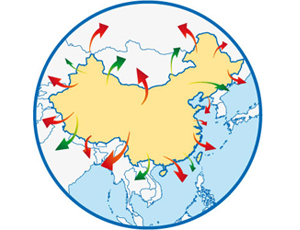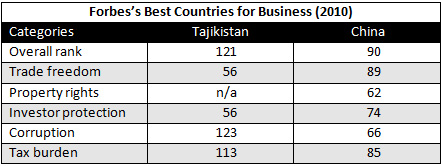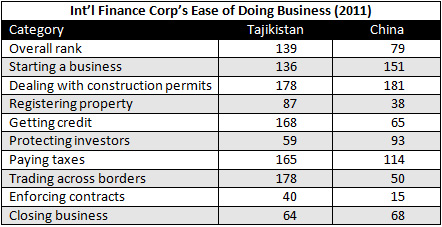The China Alternative – Tajikistan
 The China Alternative is our series covering other manufacturing destinations in emerging Asia that may start to compete with China in terms of labor costs, infrastructure and operational capacity. In this issue we look at Tajikistan.
The China Alternative is our series covering other manufacturing destinations in emerging Asia that may start to compete with China in terms of labor costs, infrastructure and operational capacity. In this issue we look at Tajikistan.
By Lena Xia
Aug. 12 – As a relatively young Central Asian nation that is only slightly larger than Greece or Nicaragua, the Republic of Tajikistan is not typically considered a major player in the grand scheme of global economics and politics. Meanwhile, the five-year civil war (2002-2007) between the Moscow-backed government and the Islamist-led opposition undoubtedly has severely damaged the country’s already fragile economic infrastructure and caused a sharp decline in industrial and agricultural production. However, in the wake of a UN peace agreement, Tajikistan now is slowly recovering and actively seeking foreign investment as it seeks to catch up with many of the rapidly expanding economies in the region, such as China, Mongolia, India and Kazakhstan, while it also hopes to avoid the pitfalls currently debilitating other regional players including Afghanistan and Pakistan.
Economic overview
According to the CIA World Factbook, Tajikistan has one of the lowest per capita GDPs among the 15 former Soviet republics. And due to a lack of employment opportunities in the country, as many as 1 million Tajik citizens work abroad – primarily in Russia – and their remittances make up almost half of the country’s GDP. Also, the fact that Tajikistan’s foreign revenue is precariously dependent upon exports of cotton and aluminum, and on remittances from Tajik migrant workers abroad, is making the country’s economy highly vulnerable to external shocks.
With an area of 143,100 square kilometers and a population of approximately 7.6 million, Tajikistan is the world’s 96th largest country by land mass and the 96th most populous country. This landlocked country lies to the west of China and south of Kyrgyzstan. To help increase north-south trade, the United States funded a US$36 million bridge that opened in August 2007 linking Tajikistan with Afghanistan. Meanwhile, Tajikistan has received substantial infrastructure development loans from the Chinese government to improve roads and electricity transmission.
Tajikistan is an agricultural economy but less than 7 percent of the land area is arable. Cotton is the most important crop and its production is closely monitored or in many cases, even controlled by the government. Following the National Bank of Tajikistan’s admission in December 2007 that it had improperly lent money to investors in the cotton sector, the IMF canceled its program in Tajikistan. Currently, a reform agenda is underway with which over US$500 million in farmer debt will be forgiven.
Other agricultural activities include stock raising, beekeeping and processing of vegetables, fruit, wool and leather. The government promises to significantly increase the country’s export capacities by applying modern technologies.
Generally, Tajikistan’s industry consists only of a large aluminum plant, hydropower facilities, and small obsolete factories mostly in light industry and food processing. Mineral resources include silver, gold, uranium, and tungsten. The country claims to have almost all of the elements on the periodic table.
In addition, electricity output expanded with completion of the Sangtuda-I hydropower dam, which was finished in 2009 with Russian investment. The Iranian invested Sanguda-II is scheduled for completion in 2012. If finished according to Tajik plans, the Roghun dam will be the tallest dam in the world – the government of Tajikistan is pinning major hopes on this massive project.
Global business rankings
In Forbes’ “Best Countries for Business” index, Tajikistan was ranked a lowly 121st out of 128 markets in 2010, which is a slight improvement from its rank of 123st in 2009. When compared to the economic giant China, Tajikistan is doing relatively better in terms of trade freedom (56th vs. 89th) and investor protection (56th vs. 74th). Tajikistan has made an effort to attract foreign capital by means of including corresponding laws which will be discussed in details later in this article.

In its “Ease of Doing Business” index, another leading global business ranking system, International Finance Corporation ranked Tajikistan 139th out of 183 nations in 2011, which is an improvement from its position of 149th in 2010. Tajikistan’s economy has yet just been brought back to the right track that its overall ranking is inevitably towards the lower end; however, it receives a score of 59 in terms of protecting investors, which definitely will help boost Tajikistan’s image when competing with other countries for overseas investment. To those who are seeking possible China alternatives, it is worth knowing that Tajikistan has a significantly better ranking than China in terms of starting a business.

Foreign investment
Foreign investment is Tajikistan’s vital means of economic revival. As the country’s peace process evolves and economic stability returns, the government has been putting a great deal of effort into making Tajikistan a more attractive destination for foreign direct investment. In 2007, Tajikistan established the Law of the Republic of Tajikistan on Investment, which is aimed at creating a better investment environment, improved government transparency, the utilization of the foreign capital, and further adaptation of the international norms.
Some incentives and facilities accorded by the government to foreign investors are:
- Tajikistan laws and international laws recognized by the Republic of Tajikistan will provide investors with full unconditional rights protection.
- Foreign investors have the rights to know information that are relevant and benefit to their investment projects. The government will assist investor in acquiring necessary information.
- The government should not be interfering with investors’ legal business activities.
- Investors’ intellectual property rights will be protected.
Furthermore, in order to make Tajik a more attractive destination for foreign investment, the government has opened four Free Economic Zones (FEZs) since 2008, although only two of them are currently active. According to the director of the Sughd FEZ, the zone is working with Polish, Cypriot, Turkish and domestic capital while two more business (one Turkish and one domestic) will be opened soon.
“Unlike many countries in the region, Tajikistan has created very comfortable conditions, and therefore, we have witnessed an increased pace of development over the last year,” said an economist specializing in FEZs. “Nevertheless, the FEZs still need investor and government help. If we are going to make an effort to develop FEZs, then this will first and foremost be to create new jobs in the (non-capital) regions and the emergence of local production.”
The State Investment and Regulation Committee is considering aid for the FEZ. With the success of the existing FEZs, there will be more job opportunities, greater possibilities of opening new ones and, most importantly, Tajik migrant workers will be motivated to return from abroad.
Overview
As an underdeveloped country, Tajikistan’s business environment is moving towards a positive direction, but is still relatively immature. Its economic situation remains fragile due to uneven implementation of structural reforms, corruption, weak governance, seasonal power shortages, and the external debt burden. The government is still seeking better ways to reintegrate the nation and strengthen the rule of law. On the other hand, Tajikistan’s underdevelopment makes it a virgin land for foreign investment and a cost-saving China alternative. An international exhibition will take place in Dushanbe later this year where investors will be able to have face-to-face communications with top government officials. The exhibition is expecting to be a platform for more trading opportunities.
In an open letter from the Tajik government to the world, it says:
“Tajikistan needs your products, as you need a reliable customer for the stable development of your company.”
Related Reading
 The China Alternative Series
The China Alternative Series
Our complete series on other manufacturing destinations in Asia that are now starting to compete with China in terms of labor costs, infrastructure and operational capacity.
 China’s Neighbors
China’s Neighbors
This unique book is an introductory study of all 14 of China’s neighbor countries: Afghanistan, Bhutan, India, Kazakhstan, Kyrgyzstan, Laos, Myanmar, Mongolia, Nepal, North Korea, Pakistan, Russia, Tajikistan and Vietnam.
 Operational Costs of Business in China’s Inland Cities
Operational Costs of Business in China’s Inland Cities
It is widely held that land and labor costs in inland provinces offer quite significant cost savings over major east coast and southern cities. In this issue, we take a quick look at the numbers behind these beliefs.
- Previous Article After Wenzhou Train Wreck, China to Implement Universal Slowdown on High Speed Trains
- Next Article China Takes Anti-dumping Measures on Imported Photographic Paper


























